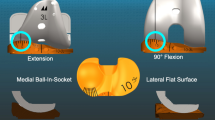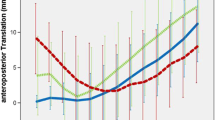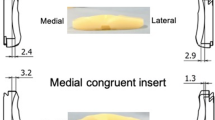Abstract
Purpose
Tibial insert conformity in total knee arthroplasty (TKA) is of interest due to the potential effect on tibiofemoral kinematics. This study determined differences in anterior–posterior movements of the femoral condyles, pivot locations, and internal tibial rotation in different arcs of flexion for two implants with different insert conformities in kinematically aligned TKA.
Methods
Twenty-five patients treated with a medial and lateral low-conforming, posterior cruciate ligament (PCL) retaining (LC CR) implant followed by a medial ball-in-socket and flat, lateral PCL sacrificing (B-in-S CS) implant in the contralateral knee underwent single-plane fluoroscopy during a deep knee bend. Analysis following 3D-to-2D image registration determined tibiofemoral kinematics and patients completed validated outcome scores for both knees.
Results
The mean follow-up of 1.6 ± 0.4 years for the knee with the B-in-S CS implant was shorter than the 2.7 ± 1.2 years for the LC CR implant. From 0º to 30º of flexion, a medial pivot occurred with the tibia rotating internally approximately 5º with both implants. From 30º to 90º, the pivot remained medial and internal rotation increased to 10º with the B-in-S CS implant. In contrast, neither femoral condyle moved more than 1 mm with the LC CR implant from 30º to 60º, but from 60º to 90º degrees, a lateral pivot occurred and internal rotation increased. Internal rotation of the tibia on the femur from 0° to maximum flexion occurred about a medial pivot similar to the native knee for the B-in-S CS implant and was 4.5° greater than that of the LC CR implant (10.4° vs 5.9°). There was no difference in the median patient-reported outcome scores between implant designs.
Conclusions
Tibial insert conformity is a primary determinant of a medial or lateral pivot during a deep knee bend. One explanation for the transition from a medial to lateral pivot between 30º and 60º with the LC CR implant is the chock-block effect of the insert’s posterolateral upslope which impedes posterior movement of the lateral femoral condyle. Because there is no posterolateral upslope in the insert of the B-in-S CS implant, the tibia pivots medially throughout flexion similar to the native knee.
Level of evidence
Level III.



Similar content being viewed by others
References
Banks SA, Hodge WA (1996) Accurate measurement of three-dimensional knee replacement kinematics using single-plane fluoroscopy. IEEE Trans Biomed Eng 43:638–649
Dennis DA, Mahfouz MR, Komistek RD, Hoff W (2005) In vivo determination of normal and anterior cruciate ligament-deficient knee kinematics. J Biomech 38:241–253
Devers BN, Conditt MA, Jamieson ML, Driscoll MD, Noble PC, Parsley BS (2011) Does greater knee flexion increase patient function and satisfaction after total knee arthroplasty? J Arthroplasty 26:178–186
Donadio J, Pelissier A, Boyer P, Massin P (2015) Control of paradoxical kinematics in posterior cruciate-retaining total knee arthroplasty by increasing posterior femoral offset. Knee Surg Sports Traumatol Arthrosc 23:1631–1637
Freeman MA, Pinskerova V (2005) The movement of the normal tibio-femoral joint. J Biomech 38:197–208
French SR, Munir S, Brighton R (2020) A single surgeon series comparing the outcomes of a cruciate retaining and medially stabilized total knee arthroplasty using kinematic alignment principles. J Arthroplasty 35:422–428
Fukubayashi T, Torzilli PA, Sherman MF, Warren RF (1982) An in vitro biomechanical evaluation of anterior-posterior motion of the knee. Tibial displacement, rotation, and torque. J Bone Joint Surg Am 64:258–264
Gray HA, Guan S, Thomeer LT, Schache AG, de Steiger R, Pandy MG (2019) Three-dimensional motion of the knee-joint complex during normal walking revealed by mobile biplane x-ray imaging. J Orthop Res 37:615–630
Gray HA, Guan S, Young TJ, Dowsey MM, Choong PF, Pandy MG (2020) Comparison of posterior-stabilized, cruciate-retaining, and medial-stabilized knee implant motion during gait. J Orthop Res 38:1753–1768
Hirokawa S, Solomonow M, Lu Y, Lou ZP, D’Ambrosia R (1992) Anterior-posterior and rotational displacement of the tibia elicited by quadriceps contraction. Am J Sports Med 20:299–306
Hoff WA, Komistek RD, Dennis DA, Gabriel SM, Walker SA (1998) Three-dimensional determination of femoral-tibial contact positions under in vivo conditions using fluoroscopy. Clin Biomech (Bristol, Avon) 13:455–472
Howell SM, Papadopoulos S, Kuznik KT, Hull ML (2013) Accurate alignment and high function after kinematically aligned TKA performed with generic instruments. Knee Surg Sports Traumatol Arthrosc 21:2271–2280
Howell SM, Shelton TJ, Gill M, Hull ML (2021) A cruciate-retaining implant can treat both knees of most windswept deformities when performed with calipered kinematically aligned TKA. Knee Surg Sports Traumatol Arthrosc 29:437–445
Johal P, Williams A, Wragg P, Hunt D, Gedroyc W (2005) Tibio-femoral movement in the living knee. A study of weight bearing and non-weight bearing knee kinematics using “interventional” MRI. J Biomech 38:269–276
Komistek RD, Dennis DA, Mahfouz M (2003) In vivo fluoroscopic analysis of the normal human knee. Clin Orthop Relat Res 410:69–81
Li G, Gill TJ, DeFrate LE, Zayontz S, Glatt V, Zarins B (2002) Biomechanical consequences of PCL deficiency in the knee under simulated muscle loads–an in vitro experimental study. J Orthop Res 20:887–892
Li G, Suggs J, Hanson G, Durbhakula S, Johnson T, Freiberg A (2006) Three-dimensional tibiofemoral articular contact kinematics of a cruciate-retaining total knee arthroplasty. J Bone Joint Surg Am 88:395–402
Mahfouz MR, Hoff WA, Komistek RD, Dennis DA (2003) A robust method for registration of three-dimensional knee implant models to two-dimensional fluoroscopy images. IEEE Trans Med Imaging 22:1561–1574
Nedopil AJ, Howell SM, Hull ML (2016) Does malrotation of the tibial and femoral components compromise function in kinematically aligned total knee arthroplasty? Orthop Clin North Am 47:41–50
Nedopil AJ, Singh AK, Howell SM, Hull ML (2018) Does calipered kinematically aligned TKA restore native left to right symmetry of the lower limb and improve function? J Arthroplasty 33:398–406
Nedopil AJ, Zamora T, Delman C, Howell SM, Hull ML (2021) Which asymmetric tibial component is optimally designed for calipered kinematically aligned total knee arthroplasty? J Knee Surg. https://doi.org/10.1055/s-0041-1728815
Nicolet-Petersen S, Saiz A, Shelton T, Howell S, Hull ML (2020) Kinematically aligned TKA restores physiological patellofemoral biomechanics in the sagittal plane during a deep knee bend. Knee Surg Sports Traumatol Arthrosc 28:1497–1507
Nicolet-Petersen S, Saiz A, Shelton T, Howell SM, Hull ML (2020) Small differences in tibial contact locations following kinematically aligned TKA from the native contralateral knee. Knee Surg Sports Traumatol Arthrosc 28:2893–2904
Pinskerova V, Johal P, Nakagawa S, Sosna A, Williams A, Gedroyc W et al (2004) Does the femur roll-back with flexion? J Bone Jt Surg Br 86:925–931
Pinskerova V, Vavrik P (2020) Knee anatomy and biomechanics and its relevance to knee replacement. Personalized hip and knee joint replacement. Springer International Publishing, New York, pp 159–168
Postolka B, Schütz P, Fucentese SF, Freeman MAR, Pinskerova V, List R et al (2020) Tibio-femoral kinematics of the healthy knee joint throughout complete cycles of gait activities. J Biomech. https://doi.org/10.1016/j.jbiomech.2020.109915
Prins AH, Kaptein BL, Stoel BC, Reiber JH, Valstar ER (2010) Detecting femur-insert collisions to improve precision of fluoroscopic knee arthroplasty analysis. J Biomech 43:694–700
Rivière C, Iranpour F, Auvinet E, Howell S, Vendittoli PA, Cobb J et al (2017) Alignment options for total knee arthroplasty: a systematic review. Orthop Traumatol Surg Res 103:1047–1056
Ross DS, Howell SM, Hull ML (2017) Errors in calculating anterior-posterior tibial contact locations in total knee arthroplasty using three-dimensional model to two-dimensional image registration in radiographs: an in vitro study of two methods. J Biomech Eng 139:121001–121010
Roth JD, Howell SM, Hull ML (2019) Analysis of differences in laxities and neutral positions from native after kinematically aligned TKA using cruciate retaining implants. J Orthop Res 37:358–369
Schutz P, Taylor WR, Postolka B, Fucentese SF, Koch PP, Freeman MAR et al (2019) Kinematic evaluation of the GMK sphere implant during gait activities: a dynamic videofluoroscopy study. J Orthop Res 37:2337–2347
Victor J, Banks S, Bellemans J (2005) Kinematics of posterior cruciate ligament-retaining and—substituting total knee arthroplasty: a prospective randomised outcome study. J Bone Joint Surg Br 87:646–655
Watanabe T, Ishizuki M, Muneta T, Banks SA (2013) Knee kinematics in anterior cruciate ligament-substituting arthroplasty with or without the posterior cruciate ligament. J Arthroplasty 28:548–552
Yue B, Varadarajan KM, Moynihan AL, Liu F, Rubash HE, Li G (2011) Kinematics of medial osteoarthritic knees before and after posterior cruciate ligament retaining total knee arthroplasty. J Orthop Res 29:40–46
Acknowledgements
The authors are grateful to the Orthopaedic Research and Education Foundation (Resident Clinician Scientist Training Grant, 19-504) and Medacta USA, Inc. for financial support.
Funding
Funding provided by the Orthopaedic Research Education and Foundation (Resident Clinician Scientist Training Grant, 19-504) and Medacta USA, Inc.
Author information
Authors and Affiliations
Contributions
CMD: grant recipient, study design, literature review, fluoroscopic imaging and data acquisition, 3D-to-2D image registration, data analysis and interpretation, statistical analysis, manuscript production, and critical revision of the manuscript. DR: data analysis and interpretation, and statistical analysis. SMH: study design, supervision, data analysis and interpretation, and critical revision of the manuscript. MLH: study design, supervision, data analysis and interpretation, statistical analysis, and critical revision of the manuscript.
Corresponding author
Ethics declarations
Conflict of interest
Dr. Howell—Medacta Inc. Consultant and Royalties. Dr. Hull—Medacta Inc. Research Support, Journal of Biomechanics Editorial Board.
Ethical approval
This was an IRB-approved study at a single institution with the following IRB number 1385598-6 (UC Davis).
Informed consent
Informed consent was obtained for all patients prior to participation in the study.
Additional information
Publisher's Note
Springer Nature remains neutral with regard to jurisdictional claims in published maps and institutional affiliations.
Rights and permissions
About this article
Cite this article
Delman, C.M., Ridenour, D., Howell, S.M. et al. The posterolateral upslope of a low-conforming insert blocks the medial pivot during a deep knee bend in TKA: a comparative analysis of two implants with different insert conformities. Knee Surg Sports Traumatol Arthrosc 31, 3627–3636 (2023). https://doi.org/10.1007/s00167-021-06668-8
Received:
Accepted:
Published:
Issue Date:
DOI: https://doi.org/10.1007/s00167-021-06668-8




